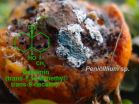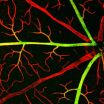(Press-News.org)
VIDEO:
Bill Hansson and Marcus Stensmyr explain their results now published in CELL.
Click here for more information.
Consuming putrid food can be lethal as it allows bacterial pathogens to enter the digestive system. To detect signs of decay and thus allowing us and other animals to avoid such food poisoning is one of the main tasks of the sense of smell. Behavioral scientists and neurobiologists at the Max Planck Institute for Chemical Ecology in Jena, Germany, have now for the first time decoded the neural mechanisms underlying an escape reflex in fruit flies (Drosophila) activated in order to avoid eating and laying eggs in food infected by toxic microorganisms. A super-sensitive and completely dedicated neural line, from olfactory receptor, via sensory neuron and primary brain neurons, is activated as soon as the tiniest amount of geosmin is in the air. Geosmin is a substance released by bacteria and mold fungi toxic to the fly. This stimulus overrides all other food odor signals, irrespective of how attractive they are on their own. Consequently, geosmin is a full STOP signal that prevents flies from eating and laying eggs in toxic food, similar to when we open the fridge and smell last week's forgotten dinner. (CELL, December 7, 2012, DOI: 10.1016/j.cell.2012.09.046)
Healthy and unhealthy microbes
The shocking number of fatalities in Germany in spring 2011 linked to fenugreek sprouts contaminated with EHEC bacteria showed that it is crucial for every foraging organism to be able to distinguish between fresh food and that infested by pathogenic microbes. Food, whether meat or vegetables, is more or less always colonized by bacteria and other microbes, their numbers varying with differing degrees of freshness and storage conditions. Usually, the immune system can cope with microorganisms in the food. Consequently, if food decay is not too far advanced, animals can digest the food without harm. But what protects us and other animals when the concentration of toxin-producing and often pathogenic microbes has become dangerously high?
Rotten smell as warning signal
In many cases visual signs allow us to avoid putrid food – who wants to bite into a rotting orange anyway? A more direct and common signal, however, is perception of certain odors released by hazardous microbes and/or their activity. If these odors are detected, the food item is directly discarded, a behavior which saves lives. But which neural functions underlie such an avoidance or even flight behavior? What does the way from the odor molecule and the olfactory receptors into the brain and finally to the reaction of the animal look like?
Geosmin and the model Drosophila
The genetically very well characterized fruit or vinegar fly Drosophila melanogaster and related species are perfect study objects to answer such a question. The flies typically feed on yeasts growing on rotting fruit. This is the stage where they must distinguish between "good" and "bad" microbes, i.e. at which stage of decomposition the fruit is. In our experiments it was shown that flies consuming pathogenic bacteria or fungi died very fast, and eggs deposited did not result in viable larvae. The odor substance geosmin is known to be produced by several fungi and bacteria and may trigger deterrent reactions. Geosmin is responsible for a smell quite familiar to us: the strong scent of wet soils, especially after droughts. The human nose is highly sensitive to this odor and can detect it at concentrations as low as 0,1 ppb (parts per billion). Max Planck scientists now found that Drosophila antennae are even more sensitive to geosmin.
"We started with electrophysiological experiments and analyzed all olfactory sensory neurons on the fly antenna successively – more than thousand measurements," says Marcus Stensmyr, first author of the study. Already at this stage, the first unexpected result became obvious: Only a single neuron type labeled "ab4B" responded to geosmin. These neurons carry the specific receptor Or56a, which we could show reacts exclusively to geosmin. The specificity could be established both in single neuron recordings linked to gas chromatography, where more than 3000 odors were tested, and in experiments using cell cultures ectopically expressing the receptor. Optical imaging of the Drosophila brain revealed another interesting result: From the approximately 50 glomeruli that constitute the antennal lobe, the olfactory center of the flies, only one, labeled DA2, was activated by geosmin. DA2 was found in the same region as other glomeruli that are involved in odor-evoked aversive behavior (see press release "Flies Process Attractive and Deterrent Odors in Different Brain Areas − Newly developed analytic device Flywalk allows accurate studies of insect behavior to be made", April 25, 2012). Stimulation of DA2 resulted in activation of a single type of a specific projection neuron (PN) conveying the message regarding geosmin presence to higher brain areas. PNs are otherwise often more broadly tuned, providing a cross-glomerulus pattern for olfactory coding. "However, this is different in the case of geosmin, Or56a, DA2 and the related PNs," says Bill Hansson, leader of the study. In this circuit, the stimulus is directly patched through from antenna to behavior, without any detours. Until now, such patterns have only been measured in the responses to sex pheromones, if that is at all comparable, report the scientists. For the first time, we see a fully dedicated neural line for an odor involved in feeding behavior.
"Flywalk" experiments confirm laboratory measurements
Behavioral assays using the recently established "Flywalk" system confirm the nerve and brain measurements in the laboratory. In the "Flywalk", single fruit flies are placed into small glass tubes, different odors are applied, and the behavior of the flies is recorded by a camera connected directly to a computer quantifying the behavior.
The geosmin stimulus, mediated through the dedicated neural line, does not only cause the flies to stop or move away from the odor source, it also overrides all simultaneously offered highly attractive odors, such as vinegar or fruit scents, at minute concentrations. This means that flies are programmed to avoid geosmin even in a mixture of different smells and will thus not be tempted to consume pathogens accidentally. This is important, because odor mixtures are the rule and not an exception in a natural environment. The response to geosmin is so strong that it also regulates oviposition behavior in females: female Drosophila laid their fertilized eggs only on substrates overgrown with ordinary yeast; they strictly avoided culture media containing the highly pathogenic geosmin producing bacterium Streptomyces coelicolor. In a Streptomyces mutant deficient in its geosmin-producing enzyme, the flies did, however, oviposit, and the larvae consequently died. Geosmin is thus sufficient and necessary to elicit the avoidance behavior. [BSH/JWK]
INFORMATION:
Original Publication:
Marcus C. Stensmyr, Hany K. M. Dweck, Abu Farhan, Irene Ibba, Antonia Strutz, Latha Mukunda, Jeanine Linz, Kathrin Steck, Sofia Lavista-Llanos, Dieter Wicher, Silke Sachse, Markus Knaden, Paul G. Becher, Yoichi Seki, Bill S. Hansson (2012).
A conserved dedicated olfactory circuit for detecting harmful microbes in Drosophila.
CELL, December 7, DOI: 10.1016/j.cell.2012.09.046
Further Information:
Prof. Dr. Bill S. Hansson, MPI Chemical Ecology, hansson@ice.mpg.de, +49 (0)3641 571401
Dr. Marcus C. Stensmyr, MPI Chemical Ecology, mstensmyr@ice.mpg.de, +49 (0)3641 571420
Picture and Movie Requests:
Angela Overmeyer M.A., +49 3641 57-2110, overmeyer@ice.mpg.de
A direct line through the brain to avoid rotten food -- a full STOP signal for Drosophila
Odor activation of a dedicated neural pathway by geosmin, an odor produced by toxic microorganisms, activates a hard-wired avoidance response in the fly
2012-12-06
ELSE PRESS RELEASES FROM THIS DATE:
Scientists identify molecules in the ear that convert sound into brain signals
2012-12-06
LA JOLLA, CA – December 6, 2012 – For scientists who study the genetics of hearing and deafness, finding the exact genetic machinery in the inner ear that responds to sound waves and converts them into electrical impulses, the language of the brain, has been something of a holy grail.
Now this quest has come to fruition. Scientists at The Scripps Research Institute (TSRI) in La Jolla, CA, have identified a critical component of this ear-to-brain conversion—a protein called TMHS. This protein is a component of the so-called mechanotransduction channels in the ear, which ...
Flexible silicon solar-cell fabrics may soon become possible
2012-12-06
For the first time, a silicon-based optical fiber with solar-cell capabilities has been developed that has been shown to be scalable to many meters in length. The research opens the door to the possibility of weaving together solar-cell silicon wires to create flexible, curved, or twisted solar fabrics. The findings by an international team of chemists, physicists, and engineers, led by John Badding, a professor of chemistry at Penn State University, will be posted by the journal Advanced Materials in an early online edition on 6 December 2012 and will be published on a ...
Hubble sees a galaxy hit a bullseye
2012-12-06
In Hubble's image, NGC 922 clearly reveals itself not to be a normal spiral galaxy. The spiral arms are disrupted, a stream of stars extends out towards the top of the image, and a bright ring of nebulae encircles the core. Observing with NASA's Chandra X-ray Observatory reveals more chaos in the form of ultraluminous X-ray sources dotted around the galaxy.
NGC 922's current unusual form is a result of a cosmic bullseye millions of years ago. A smaller galaxy, catalogued as 2MASXI J0224301-244443, plunged right through the heart of NGC 922 and shot out the other side. ...
Biochemists trap a chaperone machine in action
2012-12-06
AMHERST, Mass. – Molecular chaperones have emerged as exciting new potential drug targets, because scientists want to learn how to stop cancer cells, for example, from using chaperones to enable their uncontrolled growth. Now a team of biochemists at the University of Massachusetts Amherst led by Lila Gierasch have deciphered key steps in the mechanism of the Hsp70 molecular machine by "trapping" this chaperone in action, providing a dynamic snapshot of its mechanism.
She and colleagues describe this work in the current issue of Cell. Gierasch's research on Hsp70 chaperones ...
Image of the Carina Nebula marks inauguration of VLT Survey Telescope
2012-12-06
The latest telescope at ESO's Paranal Observatory in Chile -- the VLT Survey Telescope (VST) -- was inaugurated today at the Italian National Institute for Astrophysics (INAF) Observatory of Capodimonte, in Naples, Italy. The ceremony was attended by the Mayor of Naples, Luigi De Magistris, the INAF President, Giovanni Bignami, the ESO representatives Bruno Leibundgut and Roberto Tamai, and the main promoter of the telescope, Massimo Capaccioli of the University of Naples Federico II and INAF.
The VST is a state-of-the-art 2.6-metre telescope, with the huge 268-megapixel ...
Research on blood vessel proteins holds promise for controlling 'blood-brain barrier'
2012-12-06
Working with mice, Johns Hopkins researchers have shed light on the activity of a protein pair found in cells that form the walls of blood vessels in the brain and retina, experiments that could lead to therapeutic control of the blood-brain barrier and of blood vessel growth in the eye.
Their work reveals a dual role for the protein pair, called Norrin/Frizzled-4, in managing the blood vessel network that serves the brain and retina. The first job of the protein pair's signaling is to form the network's proper 3-D architecture in the retina during fetal development. ...
Immune system kill switch could be target for chemotherapy and infection recovery
2012-12-06
Researchers have discovered an immune system 'kill switch' that destroys blood stem cells when the body is under severe stress, such as that induced by chemotherapy and systemic infections.
The discovery could have implications for protecting the blood system during chemotherapy or in diseases associated with overwhelming infection, such as sepsis.
The kill switch is triggered when internal immune cell signals that protect the body from infection go haywire. Dr Seth Masters, Dr Motti Gerlic, Dr Benjamin Kile and Dr Ben Croker from the Walter and Eliza Hall Institute ...
Nobody's perfect
2012-12-06
Researchers at Cambridge and Cardiff have found that, on average, a normal healthy person carries approximately 400 potentially damaging DNA variants and two variants known to be associated directly with disease traits. They showed that one in ten people studied is expected to develop a genetic disease as a consequence of carrying these variants.
It has been known for decades that all people carry some damaging genetic variants that appear to cause little or no ill effect. But this is the first time that researchers have been able to quantify how many such variants each ...
Overestimation of abortion deaths in Mexico hinders maternal mortality reduction efforts
2012-12-06
This press release is available in Spanish and Portuguese.
A collaborative study conducted in Mexico by researchers of the University of West Virginia-Charleston (USA), Universidad Popular Autónoma del Estado de Puebla (Mexico), Universidad de Chile and the Institute of Molecular Epidemiology of the Universidad Católica de la Santísima Concepción (Chile), revealed that IPAS-Mexico overestimated rates of maternal and abortion mortality up to 35% over the last two decades. The research, recently published in the International Journal of Women's Health highlights that Mexico ...
Researchers discover regulator linking exercise to bigger, stronger muscles
2012-12-06
BOSTON - Scientists at Dana-Farber Cancer Institute have isolated a previously unknown protein in muscles that spurs their growth and increased power following resistance exercise. They suggest that artificially raising the protein's levels might someday help prevent muscle loss caused by cancer, prolonged inactivity in hospital patients, and aging.
Mice given extra doses of the protein gained muscle mass and strength, and rodents with cancer were much less affected by cachexia, the loss of muscle that often occurs in cancer patients, according to the report in the Dec. ...
LAST 30 PRESS RELEASES:
Deep neural networks enable accurate pricing of American options under stochastic volatility
Collective risk resonance in Chinese stock sectors uncovered through higher-order network analysis
Does CPU impact systemic risk contributions of Chinese sectors? Evidence from mixed frequency methods with asymmetric tail long memory
General intelligence framework to predict virus adaptation based on a genome language model
Antibiotic resistance is ancient, ecological, and deeply connected to human activity, new review shows
Vapes, pouches, heated tobacco, shisha, cigarettes: nicotine in all forms is toxic to the heart and blood vessels
From powder to planet: University of Modena engineers forge a low-carbon future for advanced metal manufacturing
Super strain-resistant superconductors
Pre-school health programme does not improve children’s diet or physical activity, prompting call for policy changes, study finds
Autumn clock change linked to reduction in certain health conditions
AI images of doctors can exaggerate and reinforce existing stereotypes
Where medicine meets melody – how lullabies help babies and parents in intensive care
We may never be able to tell if AI becomes conscious, argues philosopher
AI video translation shows promise but humans still hold the edge
Deep ocean earthquakes drive Southern Ocean’s massive phytoplankton blooms, study finds
Without campus leftovers to pick through, the beaks of this bird changed shape during the pandemic
High-dose antibiotic does not reduce mortality in tuberculous meningitis
How many insects fly in the sky above the USA?
Could cheese protect your brain health?
Who faces more difficulty recovering from stroke?
Colliding galaxies create the brightest, fastest growing black holes at their center
New BrainHealth research reveals tradeoffs on sleep with cannabis use for chronic pain
Aging-US now on ResearchGate, enhancing visibility for authors and readers
'Molecular glue' stabilizes protein that inhibits development of non-small cell lung cancer
Mount Sinai Health System is recognized in 2025 Chime Digital Health Most Wired survey
From prey to predator: How carnivores spread beneficial fungi
Menopause symptoms may be frequent and have negative effects, according to female endurance athletes
US Congressmembers’ responses on X to mass shooting events differ along party lines
KAIST-UEL team develops “origami” airless wheel to explore lunar caves
Individual genetic differences render some therapies ineffective
[Press-News.org] A direct line through the brain to avoid rotten food -- a full STOP signal for DrosophilaOdor activation of a dedicated neural pathway by geosmin, an odor produced by toxic microorganisms, activates a hard-wired avoidance response in the fly





